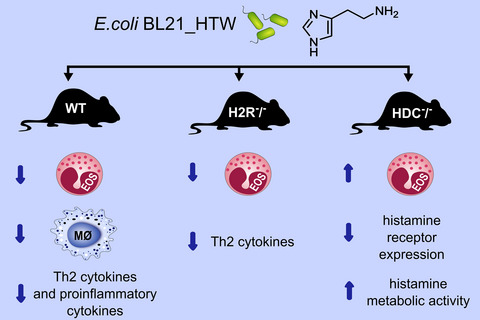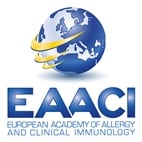Journal list menu
Export Citations
Download PDFs
ISSUE INFORMATION
Issue Information - Cover and Editorial Board
- Page: 847
- First Published: 16 May 2019
IN THIS ISSUE
GUIDELINES
EAACI Guidelines on Allergen Immunotherapy: House dust mite-driven allergic asthma
- Pages: 855-873
- First Published: 16 May 2019

POSITION PAPER
EAACI position paper: Comparing insect hypersensitivity induced by bite, sting, inhalation or ingestion in human beings and animals
- Pages: 874-887
- First Published: 15 January 2019

REVIEW ARTICLE
The functional biology of peanut allergens and possible links to their allergenicity
- Pages: 888-898
- First Published: 12 January 2019
ORIGINAL ARTICLES
Basic and Translational Allergy Immunology
Bacterial secretion of histamine within the gut influences immune responses within the lung
- Pages: 899-909
- First Published: 27 December 2018
IL-27 signaling deficiency develops Th17-enhanced Th2-dominant inflammation in murine allergic conjunctivitis model
- Pages: 910-921
- First Published: 04 December 2018
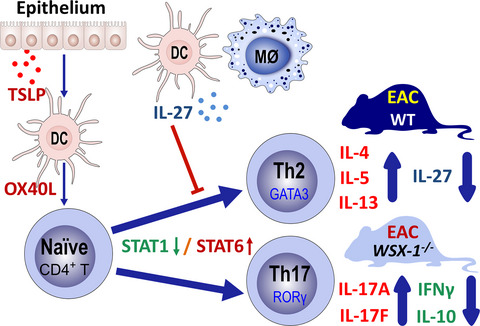
Suppressed expression and production of IL-27 were identified in serum, cervical lymph nodes, and conjunctiva in a murine model of experimental allergic conjunctivitis (EAC) with TSLP-driven Th2-dominant inflammation. The aggravated allergic inflammation was associated with enhanced Th17 hyperresponse and reduced Th1 and Treg cytokines via imbalanced activation of STAT1/STAT6 in WSX-1−/−-EAC mice deficient for IL-27 signaling. The findings uncovered novel anti-inflammatory roles and signaling pathways of IL-27 in allergic inflammation.
Asthma and Lower Airway Disease
Prostaglandin E2 decrease in induced sputum of hypersensitive asthmatics during oral challenge with aspirin
- Pages: 922-932
- First Published: 17 November 2018
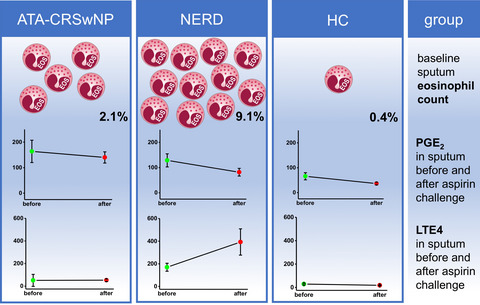
Prostaglandin E2 decreases in induced sputum of hypersensitive asthmatics during oral challenge with aspirin. In nonsteroidal anti-inflammatory drug–exacerbated respiratory disease (NERD), sputum eosinophilic count is elevated as compared to aspirin-tolerant asthmatics with chronic rhinosinusitis with nasal polyposis (ATACRSwNP) or heathy controls (HC). Prostaglandin E2 (PGE2) levels in the induced sputum are higher in asthmatics (NERD and ATA-CRSwNP) reflecting chronic inflammation of bronchi despite control of the disease. During oral aspirin challenge, cyclooxygenases are inhibited. Aspirin-provoked bronchoconstriction in NERD is accompanied by decrease of PGE2 and rise of leukotriene E4 in the induced sputum.
CCR10+ ILC2s with ILC1-like properties exhibit a protective function in severe allergic asthma
- Pages: 933-943
- First Published: 26 November 2018
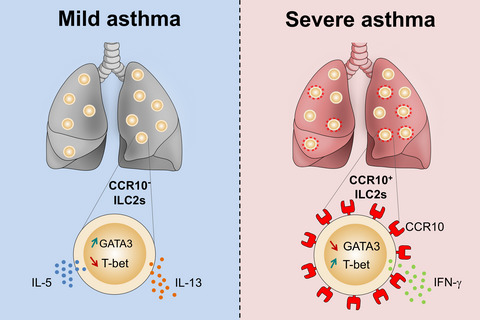
In humans, CCR10 is highly expressed by blood ILC2s in severe asthmatic patients. CCR10+ ILC2s secrete little TH2 cytokines, but exhibit ILC1-like properties, including a capacity to produce IFN-γ. T-bet expression is increased in CCR10+ ILC2s when compared to CCR10− ILC2s, whereas GATA3 expression is reduced.
Long-term outcomes in chronic hypersensitivity pneumonitis
- Pages: 944-952
- First Published: 04 December 2018
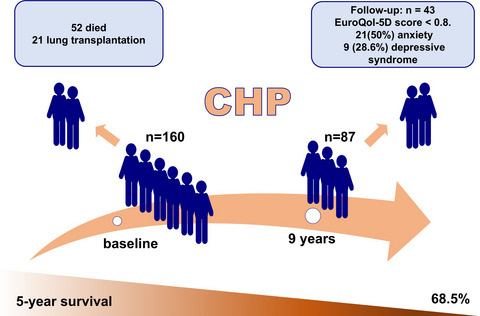
Chronic hypersensitivity pneumonitis is a severe disease with a bad mid-term prognosis. Lymphocyte values in BAL and DLCO values at baseline, presence of honeycomb in HRCT, and UIP histologic pattern were found to be predictors of survival. At follow-up, all patients presented an EuroQol-5D score < 0.8 and a probable anxiety and depressive syndrome.
Data-driven adult asthma phenotypes based on clinical characteristics are associated with asthma outcomes twenty years later
- Pages: 953-963
- First Published: 13 December 2018
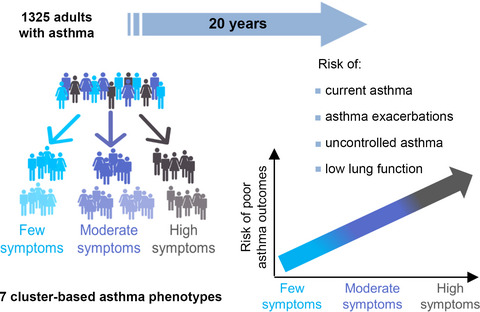
Risk for poor asthma outcomes varied between cluster-based asthma phenotypes defined 20 years earlier. The clinical prognosis of the cluster-based asthma phenotypes was stronger as compared to classical phenotypes. There was a tracking of asthma activity and lung function over the life course for each asthma cluster.
Atopic Dermatitis, Urticaria and Skin Disease
Inverted U-shaped relationship between vitamin D and ever-reported eczema in US adults
- Pages: 964-975
- First Published: 27 December 2018
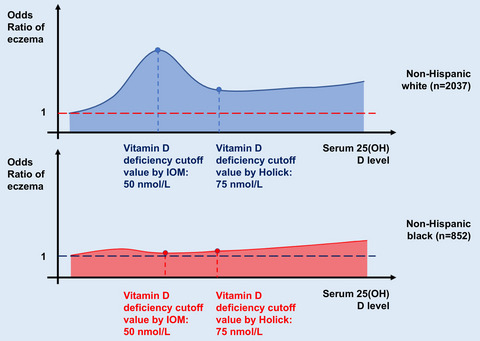
We found an inverted U-shaped relationship between ever-report of eczema and serum 25(OH)D level among US adults. There is a racial difference, as this relationship was observed among nonHispanic white population, but not nonHispanic black population. We see more reduction in risk of eczema beyond 75 nmol/L of vitamin D sufficiency level.
Allergen-Specific Immunotherapy and Biologics
Der p 1-specific regulatory T-cell response during house dust mite allergen immunotherapy
- Pages: 976-985
- First Published: 28 November 2018
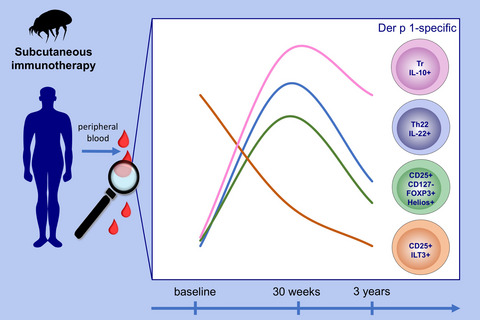
Allergen-specific immunotherapy induces an increase in activated Treg cells, IL-10-producing Treg cells, IL-22- producing Th cells, and reduces dysfunctional ILT3+ CD25+ Treg cells. Increased number of FOXP3+Helios+, IL-10+ and decreased ILT3+ Treg cell responses correlated with improved allergic symptoms. Allergen-specific immunotherapy improves clinical symptoms which relates to the correction of dysregulated T cell responses.
Chemically modified peanut extract shows increased safety while maintaining immunogenicity
- Pages: 986-995
- First Published: 02 December 2018
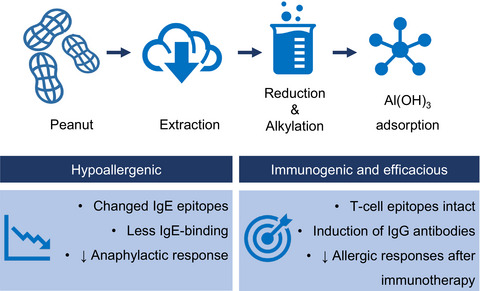
A modified peanut extract (MPE), made by reduction and alkylation, followed by aluminum hydroxide (Al(OH)3) adsorption was similar or more immunogenic than unmodified peanut extract (PE). MPE demonstrated strongly improved safety compared to PE in relevant in vitro and in vivo assays. MPE showed efficacy in a murine model for immunotherapy, which supports further development of modified peanut allergens for subcutaneous immunotherapy.
LETTERS TO THE EDITOR
Triclosan-induced alteration of gut microbiome and aggravation of asthmatic airway response in aeroallergen-sensitized mice
- Pages: 996-999
- First Published: 24 October 2018
Omalizumab discontinuation in children with severe allergic asthma: An observational real-life study
- Pages: 999-1003
- First Published: 27 November 2018
Smoking habits among adolescents with asthma – data from a population-based birth cohort
- Pages: 1003-1005
- First Published: 04 December 2018
The relationship of habitual diet with esophageal inflammation and integrity in eosinophilic esophagitis
- Pages: 1005-1009
- First Published: 04 December 2018
Three-dimensional structure of the wheat β-amylase Tri a 17, a clinically relevant food allergen
- Pages: 1009-1013
- First Published: 04 December 2018
Genotype-phenotype correlations in Brazilian patients with hereditary angioedema due to C1 inhibitor deficiency
- Pages: 1013-1016
- First Published: 17 December 2018
Cleanliness, hygienic habits, and aeroallergen sensitization: German Bitterfeld 3 study
- Pages: 1017-1019
- First Published: 27 December 2018
Cytokine genes show distinct polymorphism pattern in Hymenoptera venom allergy
- Pages: 1020-1022
- First Published: 27 December 2018
B-cell phenotype and function in infants with egg allergy
- Pages: 1022-1025
- First Published: 27 December 2018





